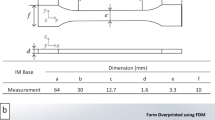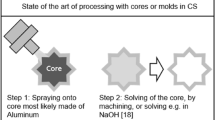Abstract
Molding technologies associated with fabricating macro scale polymer components such as injection molding and hot embossing have been adapted with considerable success for fabrication of polymer microparts. While the basic principles of the process remain the same, the precision with which the processing parameters need to be controlled especially in the case of molding high aspect ratio (HAR) polymer microparts into polymer sheets is much greater than in the case of macro scale parts. It is seen that the bulk effects of the mold insert fixture and molding machine have a dominant influence on the molding parameters and that differences in material parameters such as the glass transition temperature (T g) of polymer sheets are critical for the success and typically differ from sheet to sheet. This makes it very challenging to establish standard processing parameters for hot embossing of sheet polymers. In the course of this paper, a methodology for developing a hot embossing process for HAR microstructures based on known material properties and considering the cumulative behavior of mold, material, and machine will be presented. Using this method force–temperature–deflection curves were measured with the intent of fine tuning the hot embossing process. Tests were carried out for different materials using a dummy mold insert yielding information that could be directly transferred to the actual mold insert with minimum development time and no risk of damage to the actual microstructures.







Similar content being viewed by others
References
Bacher W et al (1998) Fabrication of LIGA mold inserts. Microsyst Technol 4(3):117–119
Boehringer Ingelheim microParts webpage (2005) Product information on Nebulizer-technology, microfluidics, and microoptics.http://www.boehringer-ingelheim.de/produkte/mikrosystemtechnik/microtechnology/index.jsp
Buser R (2002) MEMS devices for laboratory automation in the biomedical field. Mstnews 1/02:10–12
Gerlach A et al (2002) Microfabrication of single-use plastic microfluidic devices for high-throughput screening and DNA analysis. Microsyst Technol 7(5–6):265–268
Heckele M, Schomburg K (2004) Review on micro molding of thermoplastic polymers. J Micromach Microeng, p 14
Heyderman LJ et al (2001) Nanofabrication using hot embossing lithography and electroforming. Microelectron Eng 57–8:375–380
Hoeper R, Menz A (2005) Manufacturing of microfluidic devices in silicon and plastics by deep reactive ion etching. Mstnews 2/05:40–41
Juang YJ, Lee LJ, Koelling KW (2002a) Hot embossing in microfabrication. Part II: Rheological characterization and process analysis. Polymer Eng Sci 42(3):551–566
Juang YJ, Lee LJ, Koelling KW (2002b) Hot embossing in microfabrication. Part I: Experimental. Polymer Eng Sci 42(3):539–550
Kricka LJ et al (2002) Fabrication of plastic microchips by hot embossing. Lab Chip 2(1):1–4
Lee GB et al (2001) Microfabricated plastic chips by hot embossing methods and their applications for DNA separation and detection. Sens Actuators B Chem 75(1–2):142–148
Liu X, Bejat Y, Murphy MC, Nikitopoulos N, Soper SA (2004) PCR in a continuous flow polymer-based microdevice. Part 1: Theoretical considerations, Part 2: Fabrication and applications. JMEMS (submitted)
MacDermott CP, Shenoy AV (1997) Selecting thermoplastics for engineering applications, 2nd edn. Marcel Dekker, New York
Roetting O et al (2002) Polymer microfabrication technologies. Microsyst Technol 8(1):32–36
Schift H et al (2001) Pattern formation in hot embossing of thin polymer films. Nanotechnology 12(2):173–177
Schift H et al (2000) Nanoreplication in polymers using hot embossing and injection molding. Microelectron Eng 53(1–4):171–174
Truckenmuller R et al (2002) Low-cost thermoforming of micro fluidic analysis chips. JMicromech Microeng 12(4):375–379
Acknowledgments
The authors would like to thank the Defense Advanced Research Project Agency (DARPA) for providing funds under contract N66001-01-1-8968 to purchase the hot embossing machine and to CAMD and the State of Louisiana to support the experiments.
Author information
Authors and Affiliations
Corresponding author
Rights and permissions
About this article
Cite this article
Datta, P., Goettert, J. Method for polymer hot embossing process development. Microsyst Technol 13, 265–270 (2007). https://doi.org/10.1007/s00542-006-0183-2
Received:
Accepted:
Published:
Issue Date:
DOI: https://doi.org/10.1007/s00542-006-0183-2




